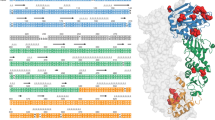Abstract
LEA group I, II and III antibodies all recognised soluble proteins present in an extract of yeast (Saccharomyces cerevisiae). The smaller protein of the two recognised by the group I antibody displayed identical migration on SDS-PAGE to the pea seed LEA group I protein against which the antibody was raised. However, the antibody failed to recognise the predominant protein present after heating the extract at 80 °C for 10 min. This predominant protein, which also displayed identical migration on SDS-PAGE, was purified from the supernatant of the extract heated at 80 °C for 10 min. Peptide sequencing after CNBr cleavage identified the isolated protein as the heat shock protein HSP 12. Despite a previous report that HSP 12 is a heat shock protein, HSP 12 was found to increase in yeast grown at 37 °C compared with growth at 30 °C . However, increased amounts of HSP 12 were present in yeast after entry into stationary phase; this was enhanced by growth in the osmolytes NaCl and mannitol.
Similar content being viewed by others
References
Baker J, Steele C, Dure III L: Sequence and characterization of 6 LEA proteins and their genes from cotton. Plant Mol Biol 11: 227–291 (1988).
Blackman SA, Wettlaufer SH, Obendorf RL, Leopold AC: Maturation proteins associated with desiccation tolerance in soybean. Plant Physiol 96: 868–874 (1991).
Blackman SA, Obendorf RL, Leopold AC: Desiccation tolerance in developing soybean seeds: the role of stress proteins. Physiol Plant 93: 630–638 (1995).
Brandt WF, Alk H, Chauhan M, Von Holt C: A simple modification converts the spinning cup sequencer into a vapour phase sequencer. FEBS Lett 174: 228–232 (1984).
Bray EA: Molecular responses to water deficit. Plant Physiol 103: 1035–1040 (1993).
Butler WM, Cuming AC: Differential molecular responses to abscisic acid and osmotic stress in viviparous maize embryos. Planta 189: 47–54 (1993)
Craig EA, Gambill BD, Nelson, RJ: Heat shock proteins: molecular chaperones of protein biogenesis. Microbiol Rev 57: 402–414 (1993)
Close TJ, Kort AA, Chandler PM: A cDNAbased comparison of dehydrationinduced proteins (dehydrins) in barley and corn. Plant Mol Biol 13: 95–108 (1989).
Close TJ, Fenton RD, Moonan F: A view of plant dehydrins using antibodies specific to the carboxy terminal peptide. Plant Mol Biol 23: 279–286 (1993).
Curry J, Morris CF, WalkerSimmons MK: Sequence analysis of a cDNA encoding a Group 3 LEAmRNAinducible by ABA or dehydration stress in wheat. Plant Mol Biol 16: 1073–1076 (1991).
Dure III L, Crouch M, Harada J, Ho TD, Mundy J, Quatrano R, Thomas T, Sung ZR: Common amino acid sequence domains among the LEA proteins of higher plants. Plant Mol Biol 12: 475–486 (1989).
Espelund M, SæbøeLarssen S, Hughes DW, Galau GA, Larsen F, Jakobsen KE: Late embryogenesisabundant genes encoding proteins with different numbers of hydrophilic repeats that are regulated differentially by abscisic acid and osmotic stress. Plant J 2: 241–252 (1992).
Gröpper T, Kensing L: Inhibitors of proteases and other stressors induce lowmolecularweight heatshock proteins in Saccharomyces cerevisiae. Exp Mycol 17: 46–54 (1993).
Gross T, Schulz-Harder: Induction of a proteinase by heatshock in yeast. FEMS Microbiol Lett 33: 199–203 (1986).
Harlow E, Lane D: Antibodies – A Laboratory Manual. Cold Spring Harbor Laboratory, Cold Spring Harbor, NY (1988).
Hewick RM, Hunkapiller MW, Hood LE, Dreyer WJ: A gasliquid solid phase peptide and protein sequencer. J Biol Chem 256: 7990–7997 (1981).
Imai R, Moses MS, Bray EA: Expression of an ABAinduced gene of tomato in ransgenic tobacco during periods of water deficit. J Expt Bot 46: 1077–1084 (1995).
Imai R, Chang L, Ohta A, Bray EA, Takagi M: A LEAclass gene of tomato confers salt and freezing tolerance when expressed in Saccharomyces cerevisiae. Gene 170: 243–248 (1996).
Kyte J, Doolittle RF: Asimplemethod for displaying the hydropathic character of a protein. J Mol Biol 157: 105–132 (1982).
Laemmli UK: Cleavage of structural proteins during the assembly of the head of bacteriophage T4. Nature 227: 680–685 (1970).
Lottspeich F: Microscale isocratic separation of the phenylthiohydantoin amino acid derivatives. J Chromatog 326: 321–327 (1985).
Marttila S, Tenhola T, Mikkonen A: A barley (Hordeum vulgare L.) LEA 3 protein, HVA1, is abundant in protein storage vacuoles. Planta 199: 602–611 (1996).
Parsell DA, Lindquist: The function of heatshock proteins in stress tolerance: Degradation and reactivation of damaged proteins. Annu Rev Genet 27: 437–496 (1993).
Praekelt UM, Meacock PA: HSP12, a new small heat shock gene of Saccharomyces cerevisiae: analysis of structure, regulation and function. Mol Gen Genet 223: 97–106 (1990).
Reid JL, WalkerSimmons MK: Group III late embryogenesis abundant proteins in desiccation tolerant seedlings of wheat (Triticum aestivum L.). Plant Physiol 102: 125–131 (1993)
Ruis H, Schuller C: Stress signalling in yeast. Bioessays 17: 959–965 (1995)
Russouw PS, Farrant J, Brandt W, Maeder D, Lindsey GG: Isolation and characterization of a heatsoluble protein from pea (Pisumsativum) embryos. Seed Sci Res 5: 137–144 (1995).
Russouw PS, Farrant J, Brandt W, Lindsey GG: The most prevalent protein in a heattreated extract of pea (Pisum sativum) embryos is an LEA group 1 protein; its conformation is not affected by exposure to high temperature. Seed Sci Res 7: 117–123 (1997).
Varela JCS, Praekelt UM, Meacock PA, Planta RJ, Mager WH: The S accharomyces cerevisiae HSP 12 gene is activated by the high osmolarity glycerol pathway and negatively regulated by protein kinase A. Mol Cell Biol 15: 6232–6245 (1995).
Womersley C: Biochemical and physiological aspects of anhydrobiosis. Comp Biochem Physiol 70B: 669–678 (1981).
Xu D, Duan X, Wang B, Hong B, Ho TD, Wu R: Expression of a late embryogenesis abundant protein gene, HVA1, from barley confers tolerance to water deficit and salt stress in transgenic rice. Plant Physiol 110: 249–257 (1996)
Author information
Authors and Affiliations
Rights and permissions
About this article
Cite this article
Mtwisha, L., Brandt, W., McCready, S. et al. Hsp 12 is a LEA-like protein in Saccharomyces cerevisiae. Plant Mol Biol 37, 513–521 (1998). https://doi.org/10.1023/A:1005904219201
Issue Date:
DOI: https://doi.org/10.1023/A:1005904219201




